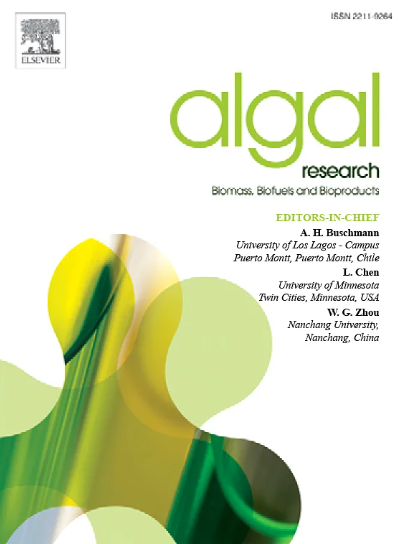Sulfated polysaccharides from Ulva rigida as antioxidant and antibacterial enhancers in chicken sausages
IF 4.6
2区 生物学
Q1 BIOTECHNOLOGY & APPLIED MICROBIOLOGY
Algal Research-Biomass Biofuels and Bioproducts
Pub Date : 2025-01-29
DOI:10.1016/j.algal.2025.103940
引用次数: 0
Abstract
In this study, ulvan polysaccharide was extracted from the green seaweed Ulva rigida using hot water extraction and characterized through various analytical techniques, including Fourier Transform Infrared (FT-IR) spectroscopy, Liquid Chromatography–Mass Spectrometry (LC-MS), Electrospray Ionization Mass Spectrometry (ESI-MS), X-ray Diffraction (XRD), and Simultaneous Thermogravimetric Analysis and Differential Scanning Calorimetry (TGA/DSC). The biological and techno-functional properties of the extracted ulvan were also evaluated. The extraction yield of ulvan from U. rigida was 19.8 ± 1.05 %. The results demonstrated that the extracted ulvan exhibited antioxidant, prebiotic, and techno-functional properties. Furthermore, it effectively inhibited the growth of Listeria monocytogenes and Escherichia coli. In the second phase of the study, the effects of different concentrations of the extracted ulvan (0.25 %, 0.5 %, and 1 %) on the cooking yield, moisture content, chemical properties (peroxide value (PV), thiobarbituric acid (TBA), and total volatile basic nitrogen (TVB-N)), microbial properties (total viable count), textural properties, color, and sensory attributes of chicken sausages were investigated over 21 days of refrigerated storage. Sausages containing ulvan showed significantly lower chemical and microbial deterioration compared to the control samples during the storage period. Moreover, ulvan-treated sausages retained higher moisture content but exhibited reduced textural properties and sensory scores. Based on these findings, it can be concluded that up to 0.5 % ulvan polysaccharide can be effectively incorporated into chicken sausages as a nutraceutical and preservative ingredient to enhance product functionality.

求助全文
约1分钟内获得全文
求助全文
来源期刊

Algal Research-Biomass Biofuels and Bioproducts
BIOTECHNOLOGY & APPLIED MICROBIOLOGY-
CiteScore
9.40
自引率
7.80%
发文量
332
期刊介绍:
Algal Research is an international phycology journal covering all areas of emerging technologies in algae biology, biomass production, cultivation, harvesting, extraction, bioproducts, biorefinery, engineering, and econometrics. Algae is defined to include cyanobacteria, microalgae, and protists and symbionts of interest in biotechnology. The journal publishes original research and reviews for the following scope: algal biology, including but not exclusive to: phylogeny, biodiversity, molecular traits, metabolic regulation, and genetic engineering, algal cultivation, e.g. phototrophic systems, heterotrophic systems, and mixotrophic systems, algal harvesting and extraction systems, biotechnology to convert algal biomass and components into biofuels and bioproducts, e.g., nutraceuticals, pharmaceuticals, animal feed, plastics, etc. algal products and their economic assessment
 求助内容:
求助内容: 应助结果提醒方式:
应助结果提醒方式:


